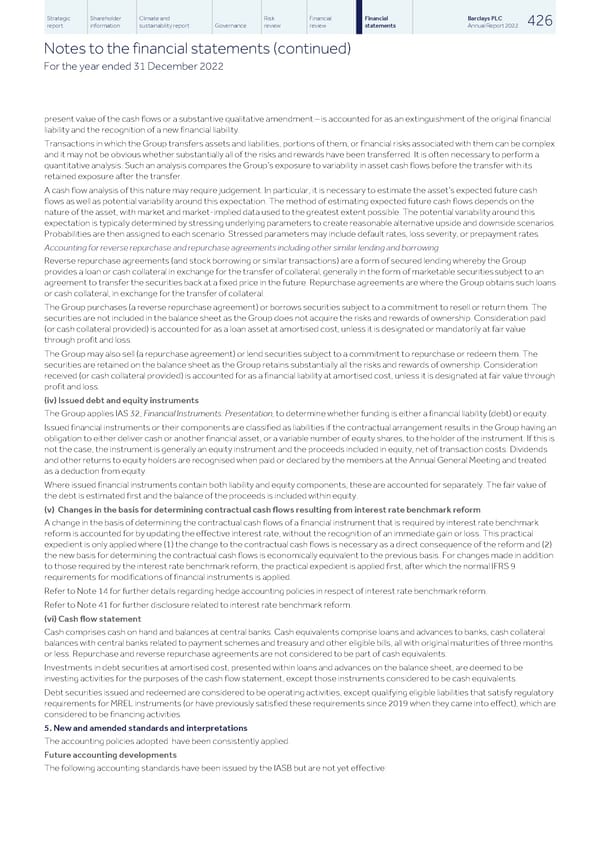Strategic Shareholder Climate and Risk Financial Financial Barclays PLC 426 report information sustainability report Governance review review statements Annual Report 2022 Notes to the financial statements (continued) For the year ended 31 December 2022 present value of the cash flows or a substantive qualitative amendment – is accounted for as an extinguishment of the original financial liability and the recognition of a new financial liability. Transactions in which the Group transfers assets and liabilities, portions of them, or financial risks associated with them can be complex and it may not be obvious whether substantially all of the risks and rewards have been transferred. It is often necessary to perform a quantitative analysis. Such an analysis compares the Group’s exposure to variability in asset cash flows before the transfer with its retained exposure after the transfer. A cash flow analysis of this nature may require judgement. In particular, it is necessary to estimate the asset’s expected future cash flows as well as potential variability around this expectation. The method of estimating expected future cash flows depends on the nature of the asset, with market and market-implied data used to the greatest extent possible. The potential variability around this expectation is typically determined by stressing underlying parameters to create reasonable alternative upside and downside scenarios. Probabilities are then assigned to each scenario. Stressed parameters may include default rates, loss severity, or prepayment rates. Accounting for reverse repurchase and repurchase agreements including other similar lending and borrowing Reverse repurchase agreements (and stock borrowing or similar transactions) are a form of secured lending whereby the Group provides a loan or cash collateral in exchange for the transfer of collateral, generally in the form of marketable securities subject to an agreement to transfer the securities back at a fixed price in the future. Repurchase agreements are where the Group obtains such loans or cash collateral, in exchange for the transfer of collateral. The Group purchases (a reverse repurchase agreement) or borrows securities subject to a commitment to resell or return them. The securities are not included in the balance sheet as the Group does not acquire the risks and rewards of ownership. Consideration paid (or cash collateral provided) is accounted for as a loan asset at amortised cost, unless it is designated or mandatorily at fair value through profit and loss. The Group may also sell (a repurchase agreement) or lend securities subject to a commitment to repurchase or redeem them. The securities are retained on the balance sheet as the Group retains substantially all the risks and rewards of ownership. Consideration received (or cash collateral provided) is accounted for as a financial liability at amortised cost, unless it is designated at fair value through profit and loss. (iv) Issued debt and equity instruments The Group applies IAS 32, Financial Instruments: Presentation, to determine whether funding is either a financial liability (debt) or equity. Issued financial instruments or their components are classified as liabilities if the contractual arrangement results in the Group having an obligation to either deliver cash or another financial asset, or a variable number of equity shares, to the holder of the instrument. If this is not the case, the instrument is generally an equity instrument and the proceeds included in equity, net of transaction costs. Dividends and other returns to equity holders are recognised when paid or declared by the members at the Annual General Meeting and treated as a deduction from equity. Where issued financial instruments contain both liability and equity components, these are accounted for separately. The fair value of the debt is estimated first and the balance of the proceeds is included within equity. (v) Changes in the basis for determining contractual cash flows resulting from interest rate benchmark reform A change in the basis of determining the contractual cash flows of a financial instrument that is required by interest rate benchmark reform is accounted for by updating the effective interest rate, without the recognition of an immediate gain or loss. This practical expedient is only applied where (1) the change to the contractual cash flows is necessary as a direct consequence of the reform and (2) the new basis for determining the contractual cash flows is economically equivalent to the previous basis. For changes made in addition to those required by the interest rate benchmark reform, the practical expedient is applied first, after which the normal IFRS 9 requirements for modifications of financial instruments is applied. Refer to Note 14 for further details regarding hedge accounting policies in respect of interest rate benchmark reform. Refer to Note 41 for further disclosure related to interest rate benchmark reform. (vi) Cash flow statement Cash comprises cash on hand and balances at central banks. Cash equivalents comprise loans and advances to banks, cash collateral balances with central banks related to payment schemes and treasury and other eligible bills, all with original maturities of three months or less. Repurchase and reverse repurchase agreements are not considered to be part of cash equivalents. Investments in debt securities at amortised cost, presented within loans and advances on the balance sheet, are deemed to be investing activities for the purposes of the cash flow statement, except those instruments considered to be cash equivalents. Debt securities issued and redeemed are considered to be operating activities, except qualifying eligible liabilities that satisfy regulatory requirements for MREL instruments (or have previously satisfied these requirements since 2019 when they came into effect), which are considered to be financing activities. 5. New and amended standards and interpretations The accounting policies adopted have been consistently applied. Future accounting developments The following accounting standards have been issued by the IASB but are not yet effective:
 Barclays PLC - Annual Report - 2022 Page 427 Page 429
Barclays PLC - Annual Report - 2022 Page 427 Page 429